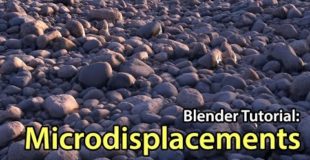https://i.ytimg.com/vi/dRzzaRvVDng/hqdefault.jpg
Blender tutorial showing you how to use the latest Micropolygon displacements and Adaptive Subdivision. Read about it: http://www.blenderguru.com/tutorials/introduction-microdisplacements
source

https://i.ytimg.com/vi/dRzzaRvVDng/hqdefault.jpg
Blender tutorial showing you how to use the latest Micropolygon displacements and Adaptive Subdivision. Read about it: http://www.blenderguru.com/tutorials/introduction-microdisplacements
source
24 responses to “Introduction to Microdisplacements – Blender Tutorial”
Of course, it's secretly and ad…
"off all the features that have arrived… this is the most exciting thing…"
Blender: hold my beer – EEVEE !
Another great tutorial. I have a question though, does microdisplacement work with CPU rendering? Either I missed it or it wasn't covered in the video.
I think this is awesome as hell, but I think I'm doing something wrong because the render takes a lot of time just to start.. Any suggestion?
Can I change the distance, in which the details become lower? Sorry if you mentioned it and I just didn't realise
I have done the steps several times over and still get no form of displacement at 19:55. Perhaps these steps are no longer relevant. Not really that cool Andrew.
Two advertisements in one video:
First, Poliigon.
Second, Pro Lighting Skies.
I have to say…my mind is blown! Both by the quality of these tutorials and how much stuff there is in Blender. I once purchased Maxon Cinema 4D back when it was V8 and it cost me soo much money that it actually totally put me off 3D and I became a coder instead. I have just come back to 3D and thought Blender was just some crappy free tool but I decided I need to start from scratch and it would be just good enough to teach myself the basics again before I would need to buy Softimage/Maxon/3Ds Max…….so my question is – why when you have Blender and the immense tutorials of Blender Guru would you need to spend 4K+???
Regarding the particles, you could create a dummy object with normal displacement modifier. You don't really need that much details for the displacement subdivision for particle positions.
I recently got OpenSuse, and I now have a few more limitations with Blender. I can't render with my graphics card unless i run Blender from the terminal. The real problem I have is that experimental mode doesn't allow adaptive subdivision, and might not actually change anything. Does this have anything to do with OpenSuse? I'm lost
Does blender support now to blend different materials with displacement transition smoothing ?
Nice!!!
And it fail when normals are connected right?
how do get that red dot cursor?
nice tutorial
Spending more time with this – I noticed that the final render takes more time with GPU tessellating, and other various (non-observable computations)… Could have just been a localized occurrence – but the render time also much account for that..
Tell you what man. blender guru has some of the best stuff on youtube. Right. there with Arumus3d.
does it work with particle systems??
There is some way to apply the adaptive subdivision?
DOOD. No, seriously. DOOOOD!
Thanks !!! 😀
i enabled experimental. I have blender 2.78. But in materials > displacement I don't have Both, True and the other. I have a random list of things, and the closest to true is Geometry | True Normal which i somehow don't think is right. so the only way i see that can displace is still with the displacement modifier? So will micro-displacements still work correctly?
hey, When using microdisplacments my object doest show up
with experimental it takes ages to build BVH
This should also work with the PBR groups you show us in the two PBR tutorials, shouldn't it?